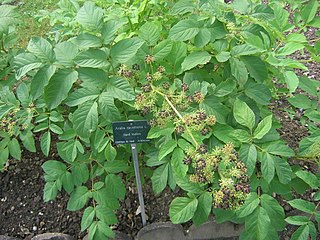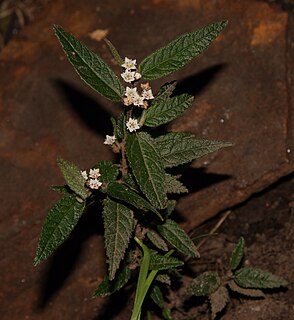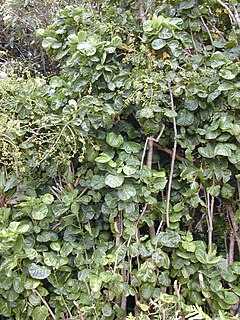
Aralia elata, commonly called Chinese angelica-tree, Japanese angelica-tree, and Korean angelica-tree, is a woody plant belonging to the family Araliaceae. It is known as tara-no-ki in Japanese, and dureup-namu (두릅나무) in Korean.

The Araliaceae is a family made of 52 genera and 700 species of flowering plants including perennial herbs, trees, vines and succulents. The family has large, usually alternate leaves, five-petaled flowers arranged in clusters, and berries. Some genera, such as 'the ivies 'Hedera, are used as ornamental foliage plants, and the family also includes the Panax ginseng, the source of ginseng used in traditional Chinese medicine.

Aralia, or spikenard, is a genus of the family Araliaceae, consisting of 68 accepted species of deciduous or evergreen trees, shrubs, and rhizomatous herbaceous perennials. The genus is native to Asia and the Americas, with most species occurring in mountain woodlands. Aralia plants vary in size, with some herbaceous species only reaching 50 centimetres (20 in) tall, while some are trees growing to 20 metres (66 ft) tall.

Aralia spinosa, commonly known as devil's walking stick, is a woody species of plant in the genus Aralia, family Araliaceae, native to eastern North America. The various names refer to the viciously sharp, spiny stems, petioles, and even leaf midribs. It has also been known as Angelica-tree.
An umbel is an inflorescence that consists of a number of short flower stalks which spread from a common point, somewhat like umbrella ribs. The word was coined in botany in the 1590s, from Latin umbella "parasol, sunshade". The arrangement can vary from being flat topped to almost spherical. Umbels can be simple or compound. The secondary umbels of compound umbels are known as umbellules or umbellets. A small umbel is called an umbellule. The arrangement of the inflorescence in umbels is referred to as umbellate, or occasionally subumbellate.

Kalopanax septemlobus, common names castor aralia, tree aralia, and prickly castor oil tree, is a deciduous tree in the family Araliaceae, the sole species in the genus Kalopanax. It is native to northeastern Asia, from Sakhalin and Japan west to southwestern China. It is called cìqiū (刺楸) in Chinese, eumnamu (음나무) in Korean, and harigiri in Japanese.

Aralia cordata is an upright herbaceous perennial plant growing up to 2 to 3 metres in height, native to Japan, Korea and eastern China. Its common names include spikenard, herbal aralia, udo, Japanese spikenard, and mountain asparagus. It is commonly found on the slopes of wooded embankments. Aralia cordata is a species of Aralia in the family Araliaceae.

Fatsia japonica, also glossy-leaf paper plant, fatsi, paperplant, false castor oil plant, or Japanese aralia, is a species of flowering plant in the family Araliaceae, native to southern Japan, southern Korea, and Taiwan.

Aralia chinensis is a species of the family Araliaceae native to China, Vietnam, and Borneo.
Aralia dasyphylla is a species in the plant genus Aralia, family Araliaceae. Its native range is western Malesia. Some sources include Aralia dasyphylloides from southern China in this species.

Aralia racemosa, with common names American spikenard, small spikenard, Indian root, spice berry, spignet, life-of-man, petty morel, is an ornamental plant in the family Araliaceae native to the United States and Canada. It is a herbaceous plant, about 1 to 2 m tall, which grows in shady areas. Its native range includes most of the eastern United States.

Aralioideae is a subfamily of flowering plants contains around 50 recognized genera. These include the genus Panax, to which ginseng belongs. Other notable species are the Angelica-tree, the devil's club, or common ivy.
Aralia elegans is a species of plant in the family Araliaceae. It is endemic to China.
Aralia tibetana is a species of plant in the family Araliaceae. It is endemic to Tibet - China.
Aralia leschenaultii is a species of plant in the family Araliaceae. It is found in China, India, Myanmar, and Sri Lanka.
Shorea dasyphylla is an endangered species of plant in the Dipterocarpaceae family. It is found in Sumatra and Borneo.
A. japonica may refer to:
F. japonica may refer to:

Commersonia dasyphylla, commonly known as kerrawang, is a species of shrub of the family Malvaceae native to eastern Australia. It was initially described by H.C. Andrews as Commersonia dasyphylla in 1810, and then placed in the genus Rulingia by Robert Sweet in 1826 where it remained until its original name was restored in 2011. The genus name commemorates 18th-century French naturalist Philibert Commerson, while the species name is derived from Ancient Greek dasys "hairy" and phyllon "leaf", and refers to cottonlike hairs covering the leaves.

Polyscias scutellaria, the shield aralia, or plum aralia, is a tropical shrub or small tree reaching 2–6 meters tall. A native of the Southwest Pacific Islands, it's commonly grown in gardens.








